DJI Air 3
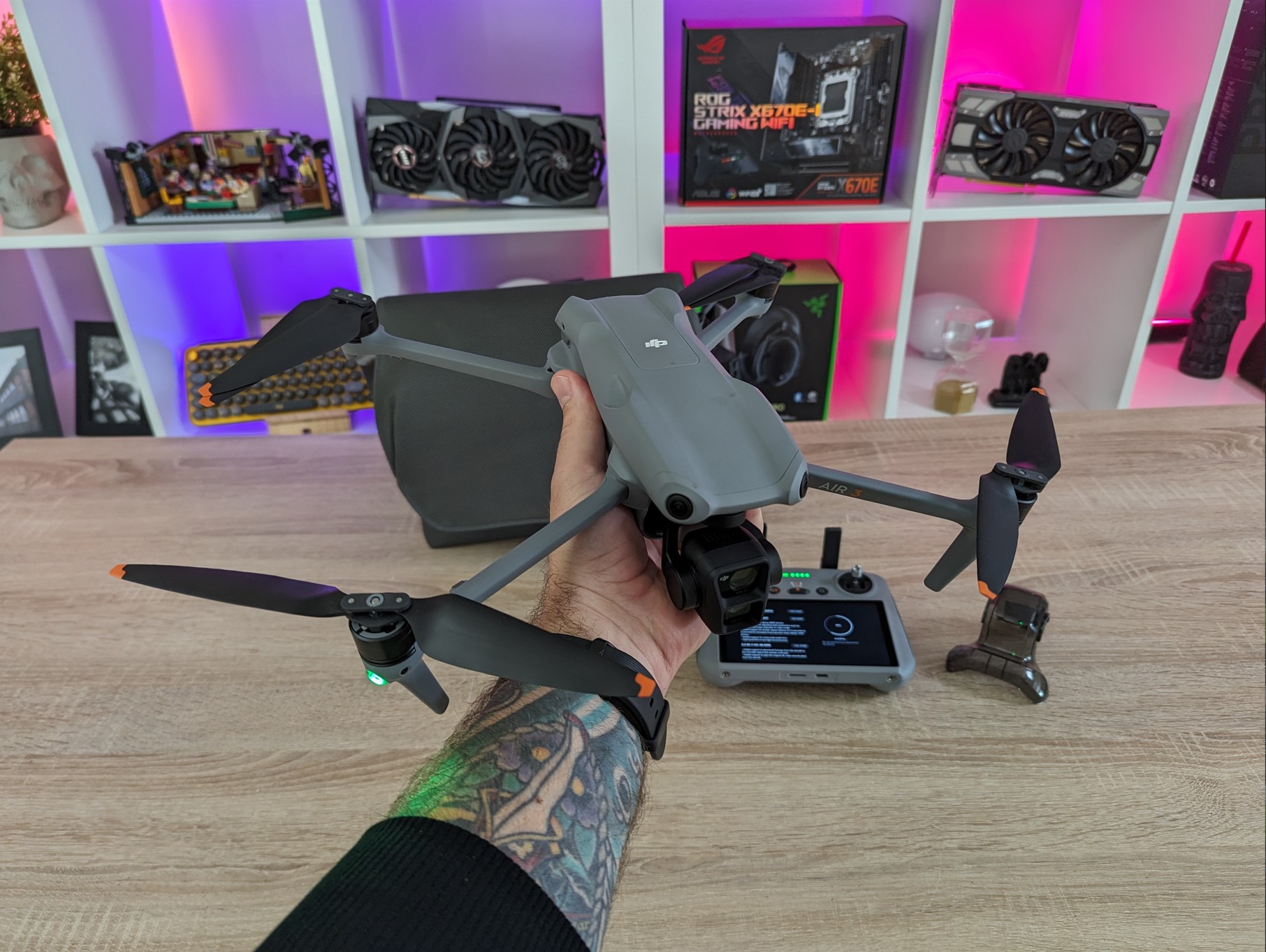
Specifications
- Takeoff Weight: 720 g
- Dimensions:
- Folded (without propellers): 207×100.5×91.1 mm (L×W×H)
- Unfolded (without propellers): 258.8×326×105.8 mm (L×W×H)
- Max Ascent Speed: 10 m/s
- Max Descent Speed: 10 m/s
- Max Horizontal Speed (at sea level, no wind): 21 m/s - 19 m/s in EU regions.
- Max Takeoff Altitude: 6000 m
- Max Flight Time: 46 minutes
- Max Hovering Time: 42 minutes
- Max Flight Distance: 32 km
- Max Wind Speed Resistance: 12 m/s
- Maximum Pitch Angle: 35°
- Operating Temperature: -10° to 40° C
- Global Navigation Satellite System: GPS + Galileo + BeiDou
- Internal storage: 8 GB
- Image Sensor
- Wide-Angle Camera: 1/1.3-inch CMOS, Effective Pixels: 48 MP
- Medium Tele Camera: 1/1.3-inch CMOS, Effective Pixels: 48 MP
- Lens:
- Wide-Angle Camera
- FOV: 82°
- Format Equivalent: 24 mm
- Aperture: f/1.7
- Focus: 1 m to ∞
- Medium Tele Camera
- FOV: 35°
- Format Equivalent: 70 mm
- Aperture: f/2.8
- Focus: 3 m to ∞
The slightly trimmed version of the very long full specification list shows us some exciting features. One of the most central is the weight, which is above the magical 250 grams. This means that the rules are somewhat more restrictive, which we will get into later.
However, another very central feature is also the dual camera setup on the DJI Air 3. It is not quite as comprehensive as the triple camera setup on the DJI Mavic 3 Pro, which we looked at some time ago.
A tour around the DJI Air 3
I have now looked at quite a few drones from DJI, and they have adapted really well to their design. Here the DJI Air 3 is no different, which is kind of a good thing. DJI has a really good recipe for their drones and when it works, there is no reason to change it.
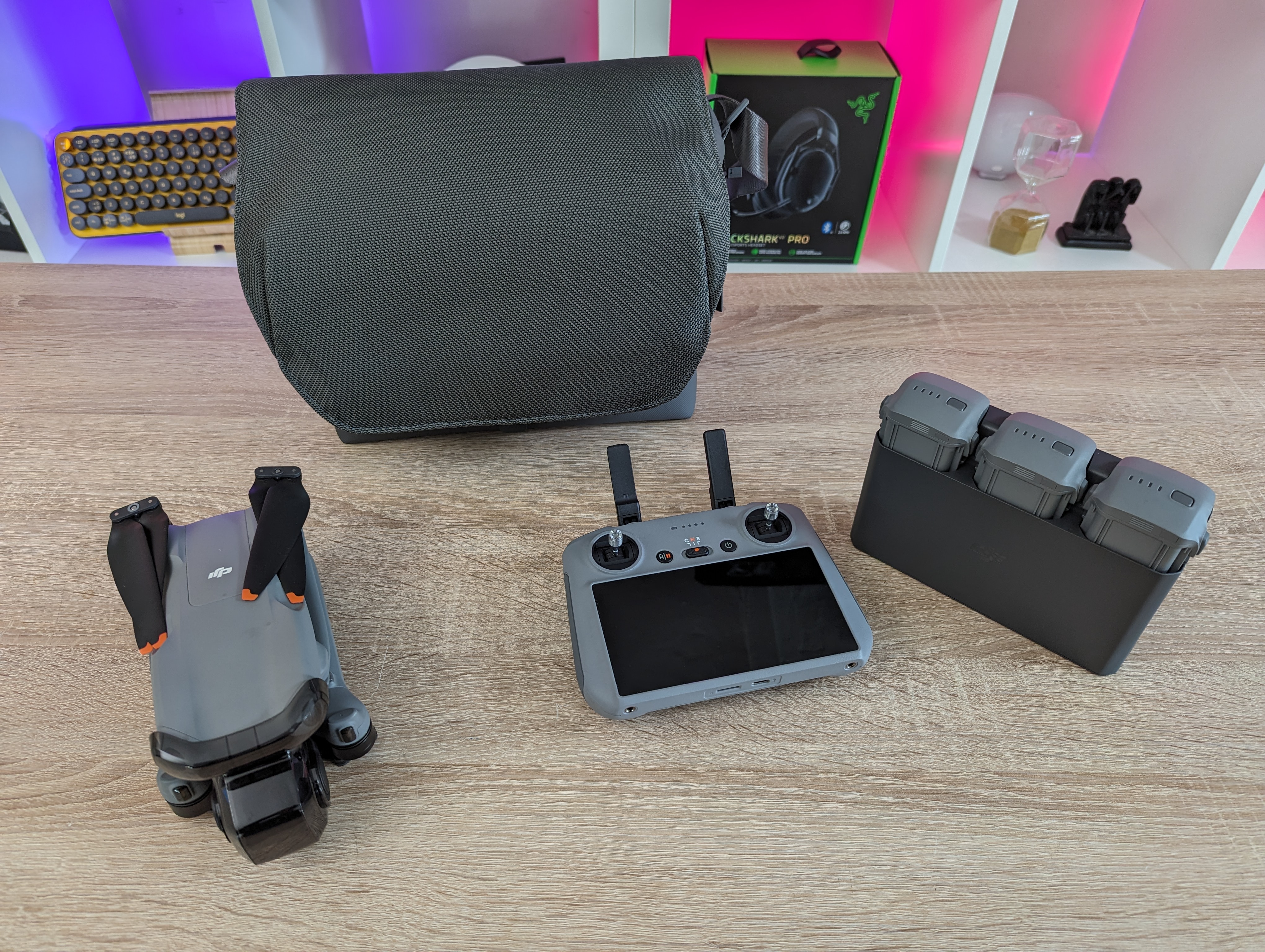
We have received the DJI Air 3 in a Fly More Combo. This means that a lot of extra equipment is included. The package consists of the Air 3 drone, a DJI RC 2 controller, three batteries gathered in a common charger frame and then extra accessories in the form of extra propellers. Everything is collected in a transport bag, so it is easy to carry everything with you.
Like most drones in this class, the DJI Air 3 is of course foldable, making it easier to store and carry.
Air 3 is equipped with a multitude of sensors so that it can automatically detect obstacles and prevent you from flying into them. There are sensors placed all around, so that under the right conditions, it can detect obstacles all around.
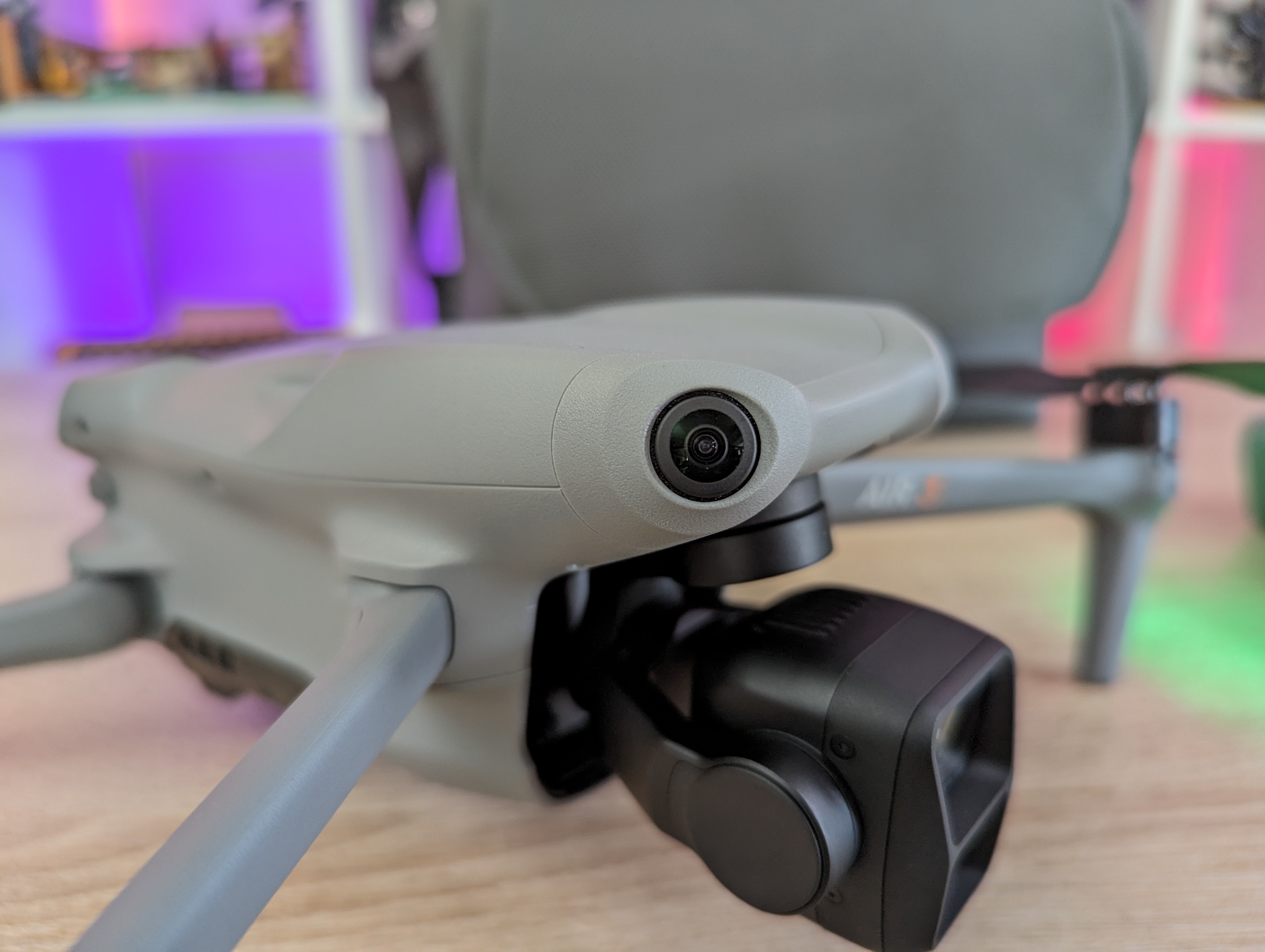
At the back of the DJI Air 3 is the location for the battery, and this is also where we find the small limb that covers the USB C connector and the space for the SD card. There is 8 GB of internal storage on the drone, so longer recordings will require an external MicroSD card. Here you have to pay attention to choosing one that is fast enough if you want to record in the high settings. DJI has a list of recommended SD cards on their website.
The drone's gimbal is one of the stars, and the Air 3 has a dual camera setup. You get a 48 MP Wide-Angle and a 48 MP Medium Tele Camera, which means you have a little more flexibility than a single camera setup.
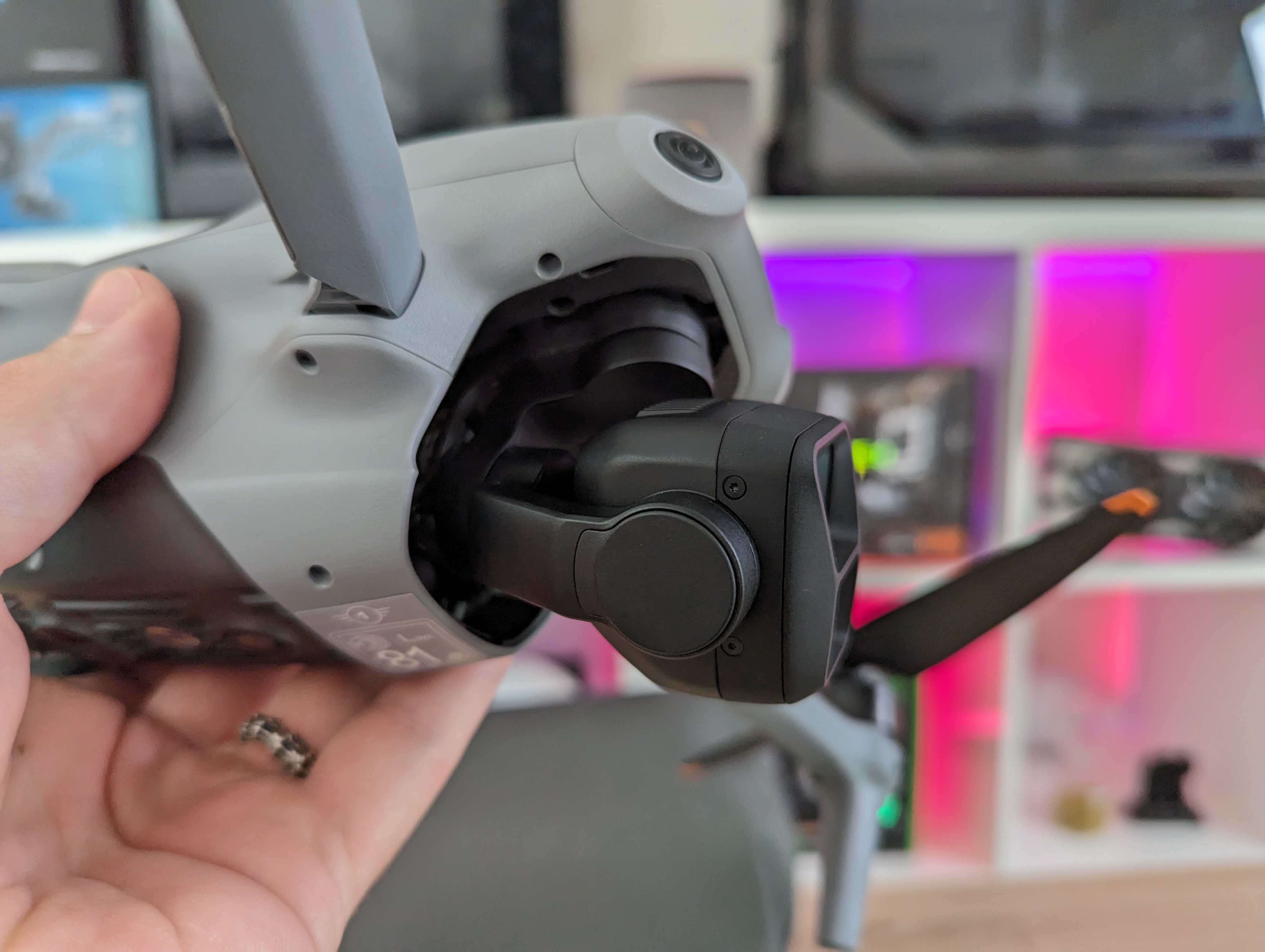
It is possible to record up to 4K with 100 FPS or 4K 60 FPS if you use the HDR setting. Both cameras also support 10-bit D-Log M and 10-bit HLG color modes, so you have better flexibility if you want to color grade your recordings yourself.
The controller that comes with the DJI Air 3 is the new DJI RC 2 controller. It has a 5.5" Full HD screen on the front and has been upgraded with a new, more powerful chipset. This means that it is better equipped to handle the control of your drone.
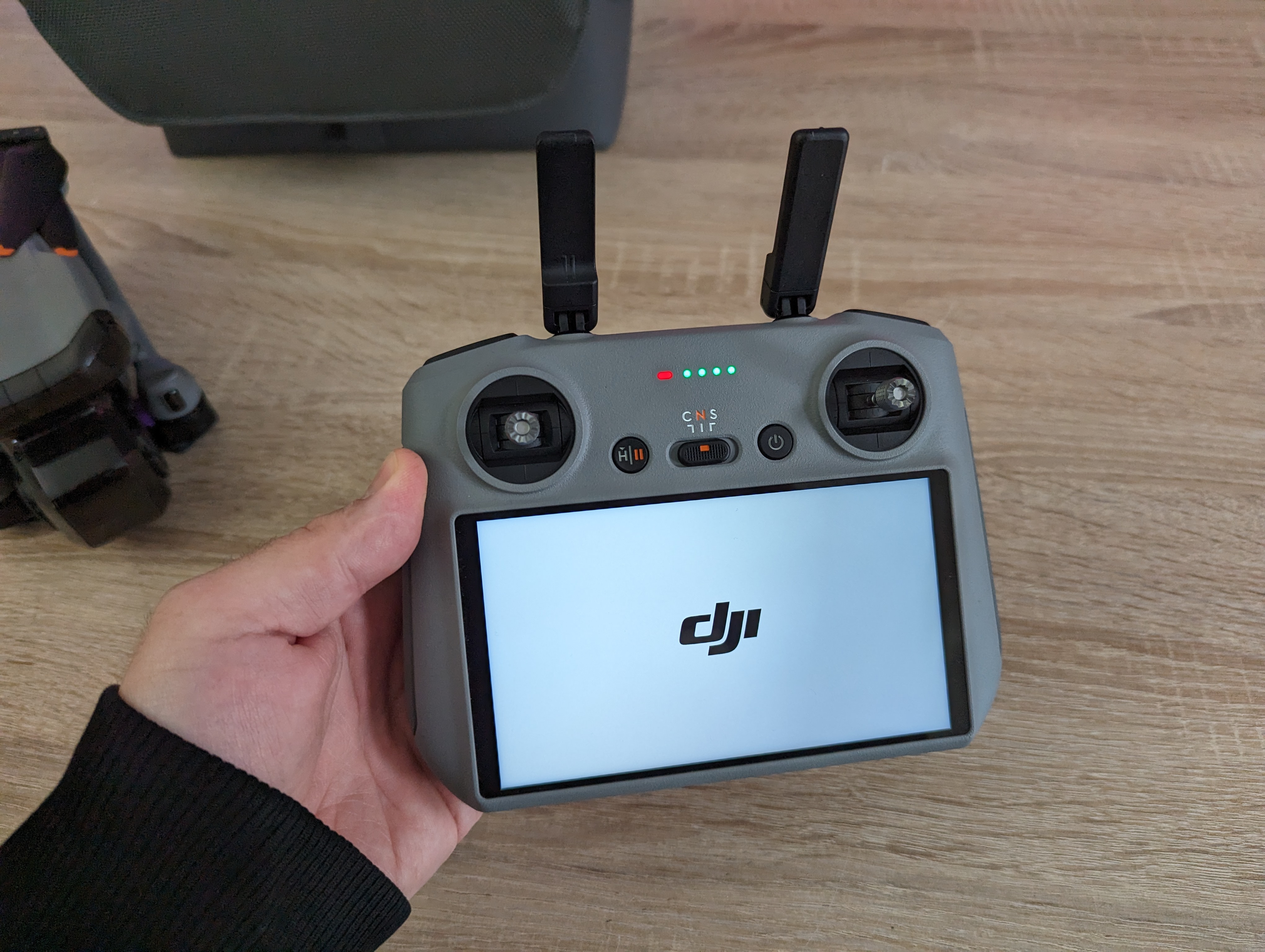
The antenna system has also been upgraded, which can be seen with two external antennas that can be folded out. It is a new 2T4R system where there are two transmitters and four receivers in the controller.
All of this should hopefully lead to better video and signal transmission, between controller and drone with a range of up to 20km.
As an added bonus, there is also 32 GB of internal storage in the RC 2 controller.
Software:
The software on which a large part of the interaction with your DJI Air 3 drone will take place is the DJI Fly app, which can be found on its smartphone, or as in our case on the DJI RC 2 device.
It is from here that you can control a large part of the functions that are built into the DJI Air 3. The control itself is of course done with the two joysticks. However, all adaptations of settings and setup of which parameters you want to fly take place through the DJI Fly software.
The drone has a range and options that go beyond the current legislation in Denmark and the EU. So it is up to you to check yourself that the settings for, for example, height, etc., are set so that they comply with the rules.
In the same way, you can specify how the drone should behave when it encounters obstacles in its path.
You can also set a ton of different things around the cameras and the gimbal that keeps it all stable.
During flight, there are a number of different status indicators that tell you things like how far the drone is from you and how much battery time is left.
In addition to the option to set the drone to avoid obstacles itself, there are also a number of other good automated functions. This includes automatic take off and landing.
Every time the DJI Air 3 takes off, it saves its GPS position. So if the drone loses connection to you and the controller, or is about to run out of battery, it will automatically return home and land. In the same way, you can at any time ask it to return home to the starting point.
The DJI Fly software seems super robust and with a lot of functions that can appeal to both the beginner and the more trained drone operator.
I experienced no problems with the software during my testing. The upgraded DJI RC 2 units handle the software quickly and without problems.
A little about Danish/EU legislation
I will not go into great depth with the law here, but just take the time to mention it. There are quite a few rules in the area, and in the worst case scenario you can be punished if you end up violating the rules for drone flying, whether it is consciously or unconsciously.
As the DJI Air 3 weighs over 250 grams, there are quite a few more limitations on it compared to any of the drones we have previously reviewed.
In order to be allowed to fly with it, you must have passed the theoretical A1/A3 test and therefore have a drone certificate, which of course must also be brought with you when you fly the drone. However, it can all be done digitally and is overall not super difficult to get through.
Another important detail is that you must have liability insurance that covers flying with drones in this category. It is an insurance that must be able to cover an insurance sum of up to DKK 7 million, which is not exactly a small thing.
There are also quite a few more restrictions on where you can fly compared to the smaller drones under 250 grams.
With the heavy drones in this class, you must keep a significantly greater safety distance and you must not fly in an area where there are unauthorized persons. This means that all flights in urban areas will in most cases be excluded or at least very limited without special permission.
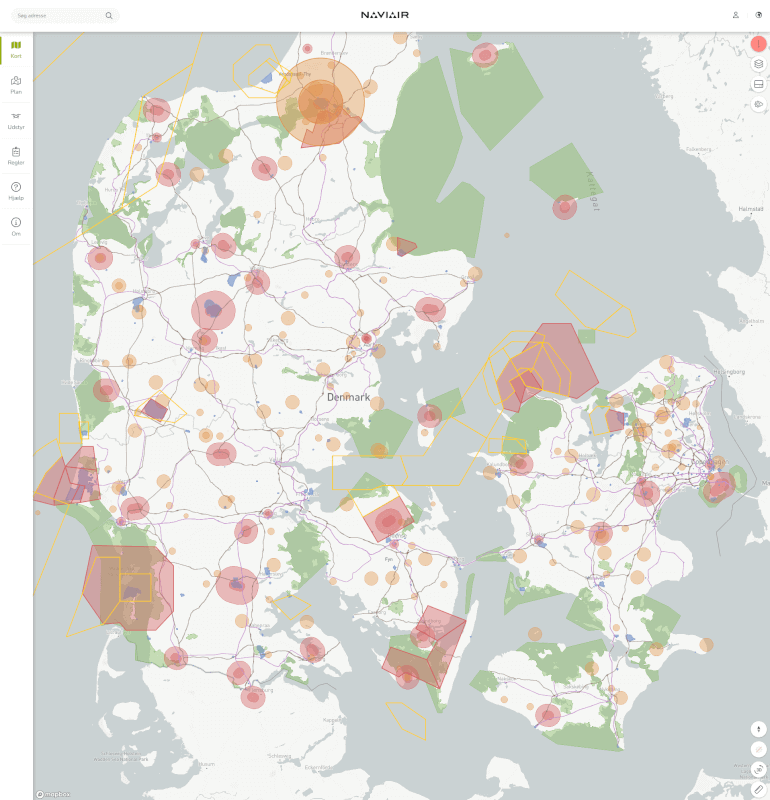
You can get slightly less restrictions by taking the more extensive A2 Drone certificate. It does, however, require that you pass a theoretical test with an examiner approved by the Danish Transport Agency.
There is also practical self-learning, where you have to familiarize yourself with the drone you want to fly with, and a series of practical maneuvers you have to go through. Here there is no test you have to pass, but it is subject to control and the possibility of being selected for control, cf. below from the Danish Transport Agency:
"The practical self-training involves some specific maneuvers that must be completed before you can declare that you have completed the practical self-training. The self-training is subject to supervision, and you will be able to be selected for control if the Swedish Transport Agency deems it necessary. If we find it unlikely that you have carried out your practical self-training, we will deprive the remote pilot of his certificate of competence. "
These more extensive rules mean that there are very naturally quite a few more restrictions on how and not least where you can use a drone like the DJI Air 3. These are details that you have to take into consideration before taking the plunge. in acquiring and flying the drone.
In addition to the above rules, you must of course still be aware of the areas where there may be restrictions on flight, even if they immediately meet the other rules about distance etc. .
You can find much more about the rules and the different types of certificates on the Swedish Transport Agency's website www.droneregler.dk
It pays to spend some time familiarizing yourself with the rules for drone flying. It is not exactly an easy web of rules to sift through. Through other work, I am used to reading legal texts and finding my way around public notices, and it took me a while to make sense of things. So if you want to be on the safe side, you should set aside some time for legal research.
The drone regulations are basically common European and apply throughout the EU. However, there may be additional rules in certain countries, so look out. Outside the EU, there may also be special rules that you must be aware of.
The test
Just as I was aware of in my test of the DJI Mavic 3 Pro, my options for test flight were quite limited, due to the strict rules for flying drones over 250 grams. This meant that this time too I kept my flights to my own plot and the fields around the house, in agreement with my neighbor who owns them.
That way I could comply with the distance requirements set up for drones over 250 grams.
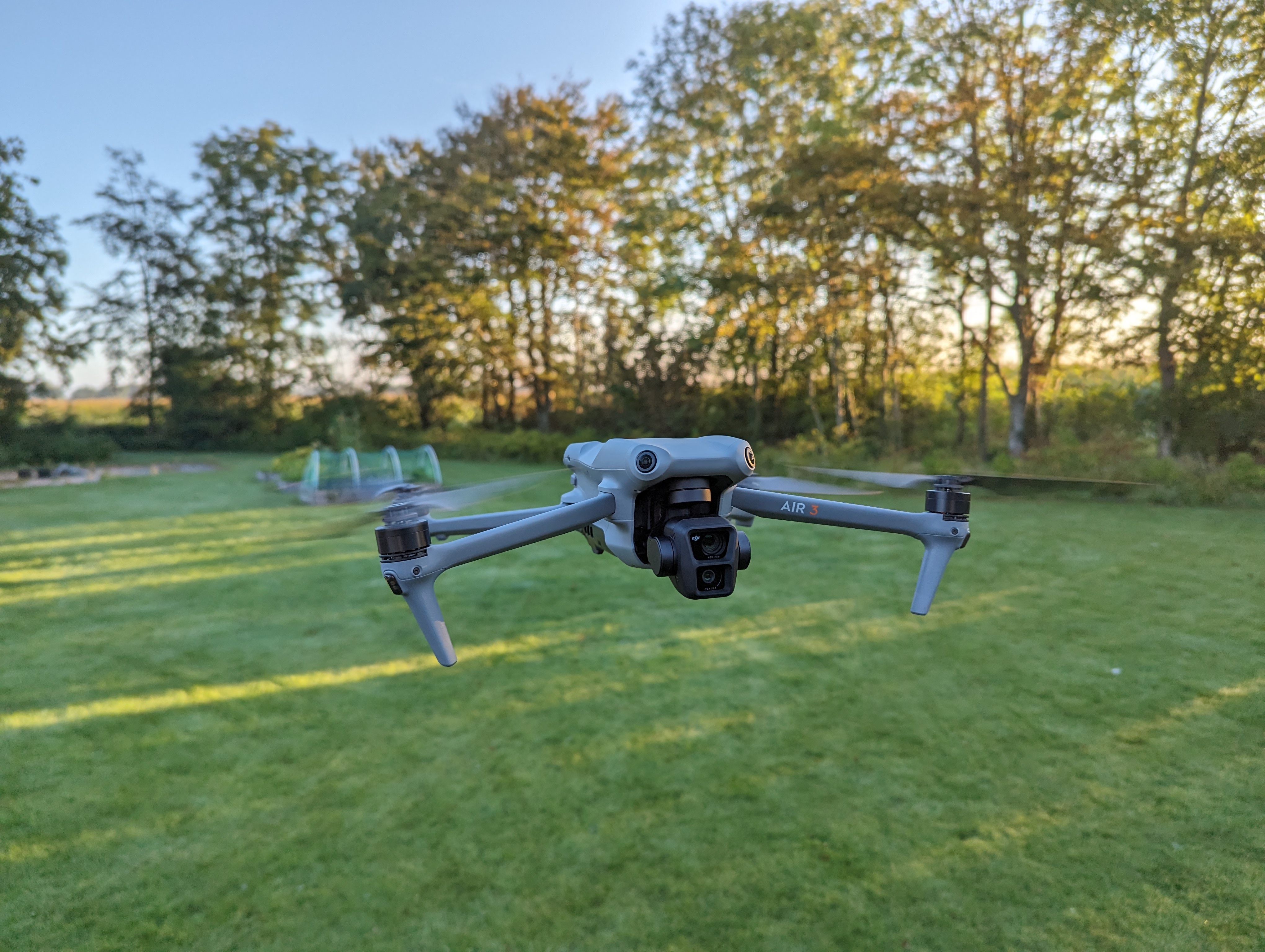
The many automatic functions built into the DJI Air 3, and most other DJI drones, mean that it is an incredibly easy drone to fly.
There is an option for automatic start and landing and the Return to Home function means that the drone automatically returns to the starting point if it loses connection to the controller or is about to run out of battery.
At the same time, the many sensors and the Object Avoidance function also mean that you are quite safe in relation to flying into things. However, you should be aware that this function only works at lower speeds up to 12m/s and the function is switched off completely if you put the drone in Sport Mode.
During my time with the DJI Air 3, I have tested it both with plantings, voluntary people and our house and every time the system has worked without any problems. Via the settings in the DJI Fly software, you can choose whether the drone should slow down or try to find a way around it when it detects an obstacle in its path.
The flight characteristics of the DJI Air 3 are super good and stable, and I am constantly amazed at the stable footage you can get from a drone whizzing across a field.
The indicated flight time of around 40 minutes has been shown during my test to be very well in line with reality. However, it will of course depend a bit on how you fly and the weather, as things like headwinds can affect the battery quite a bit.
Built into the DJI Air 3 is also a good selection of automatic functions, in addition to the Object Avoidance function. There is, just as we have seen before, a selection of different automatic recording functions where the drone can be set to track a person or an object. It can then be used to make different flight patterns, such as Dronie, Rocket, Circle, etc.
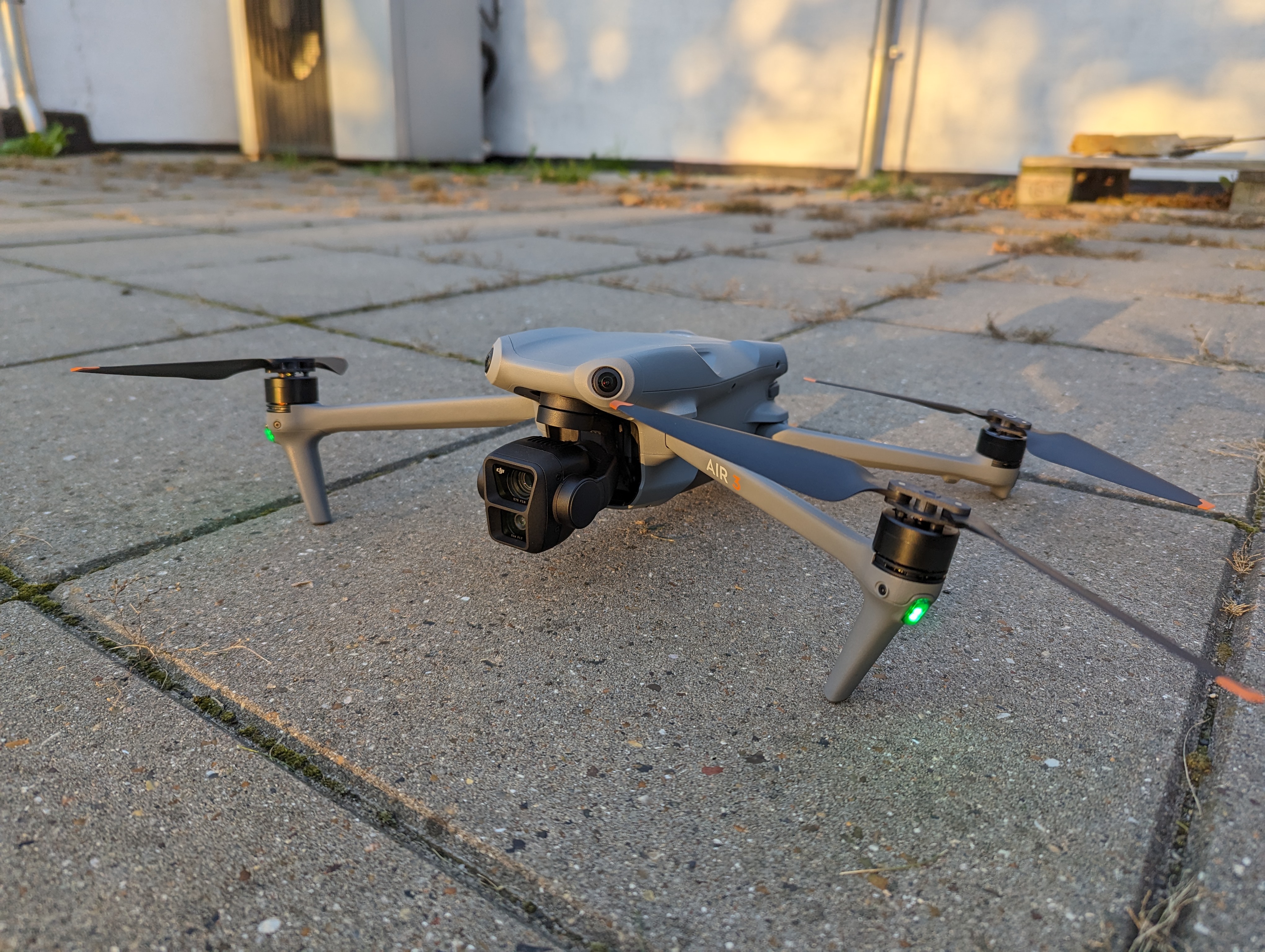
As we saw on the larger DJI Mavic 3 Pro, with the DJI Air 3 it is also possible to plan a flight route via waypoints and save it for later. It can be super practical if, for example, you want to make a timelapse video spread over several seasons or similar.
The camera is very important to most people who buy a drone, and here the DJI Air 3 certainly does not disappoint. With the option of wide angle and telephoto lenses, the two cameras offer good flexibility and images and video are fantastic on both.
It is possible to record up to 4K with a bitrate of 150 Mbps and 8-bit color or up to 10 bits if you use the HLG/D-Log M settings.
The experience of flying and recording with the DJI Air 3 has been super good throughout my test. It has been a little limited joy anyway. Just as I touched on with my review of the DJI Mavic 3 Pro, the strict rules for drones over 250 grams have limited the possibilities for unfolding.
Price
DJI Air 3 can be found in the Fly More Combo, which we have had for testing, online at the time of writing at a price of just under 2000$.
If you buy one of the smaller configurations, e.g. with an RC-N2 controller and without extra equipment, the price can be reduced to 1500$.
Conclusion
I'm left with a bit of a mixed feeling after my time with the DJI Air 3. On the one hand, it's a great drone, with good flight characteristics and fantastic cameras, at a reasonable price, all else being equal, for all the technology baked into it the system.
On the other hand, I find it difficult to recommend it solely because of the very restrictive rules for flying with it. Unfortunately, they will mean that there will be very limited opportunities to actually fly with the DJI Air 3 and take great pictures.
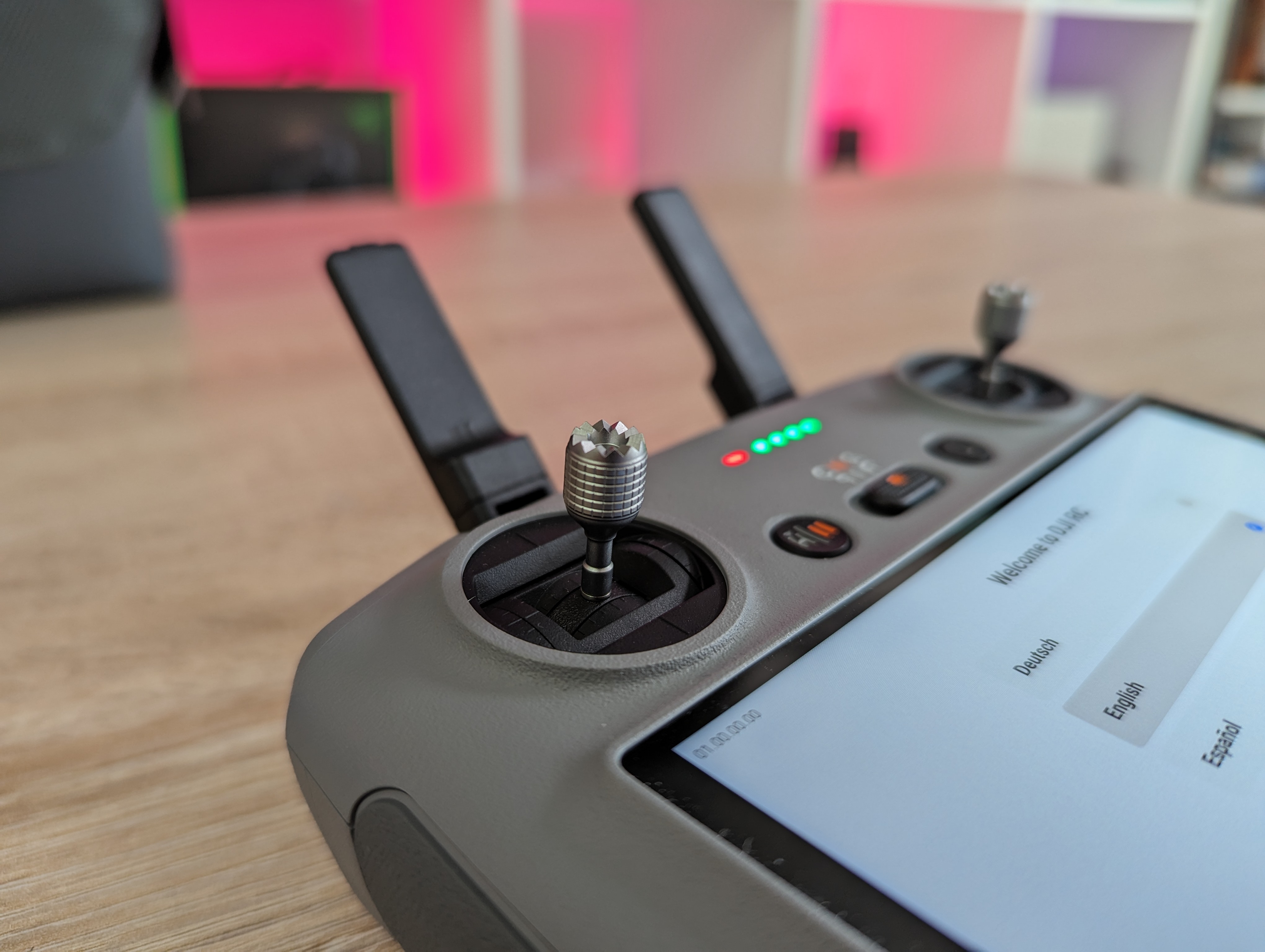
If you can see yourself working around those limitations, or you primarily want to use it in places where they don't come into play, then I would definitely recommend the DJI Air 3.
For general fun hobby use, however, it is difficult only because of the very restrictive rules. Here I would definitely recommend one of the smaller drones under 250 grams.
Despite all that, we end up with a final grade of 9, for a solid and completed product that may be limited by law.
Pros:
- Fantastic flight characteristics
- The RC 2 controller is top notch
- Top class cameras
- Good flight time
Cons:
- The rules for drones over 250 grams are very restrictive

Latest gadgets
-
23 Maygadgets
-
01 Maygadgets
Swytch launches Swytch Max+ Kit
-
10 Margadgets
DJI AIR 3S
-
03 Margadgets
Razer Wolverine V3 Pro
-
21 Febgadgets
OBSBOT Tiny 2 SE
-
13 Febgadgets
Corsair launches Platform:4
-
17 Jangadgets
Nerdytek Cycon3
-
16 Jangadgets
DJI Launches DJI Flip - A Small Foldable Drone
Most read gadgets
Latest gadgets
-
23 Maygadgets
LaserPecker LP5 Laser Engraver
-
01 Maygadgets
Swytch launches Swytch Max+ Kit
-
10 Margadgets
DJI AIR 3S
-
03 Margadgets
Razer Wolverine V3 Pro
-
21 Febgadgets
OBSBOT Tiny 2 SE
-
13 Febgadgets
Corsair launches Platform:4
-
17 Jangadgets
Nerdytek Cycon3
-
16 Jangadgets
DJI Launches DJI Flip - A Small Foldable Drone






